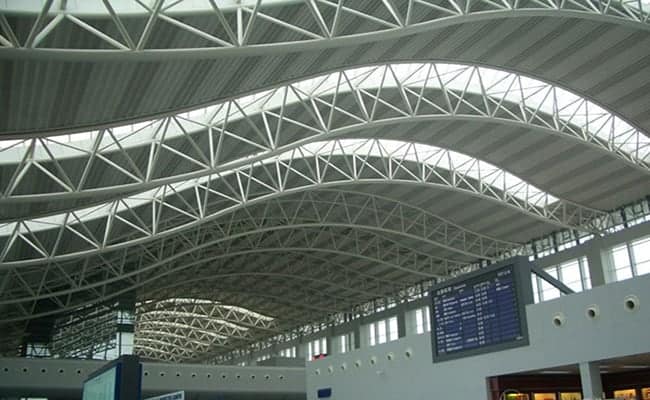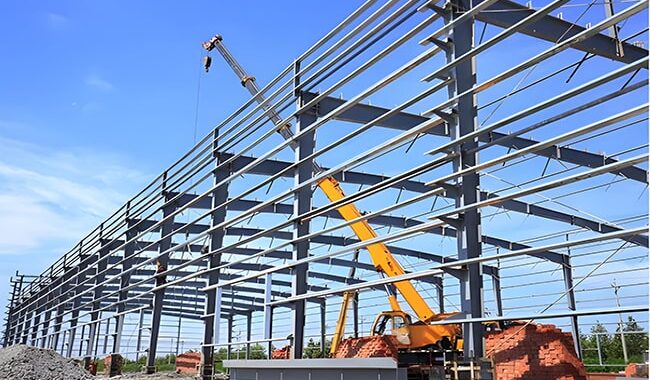In the construction of modern storage facilities, steel structure warehouses have become one of the mainstream building forms due to…
In recent years, with the continuous growth of China’s steel production, steel structures have accounted for an increasing proportion of buildings due to their advantages, and steel tube truss structures have also made breakthroughs. The most significant advantage of the steel tube truss is that it can perfectly combine people’s functional, sensory, and economic benefit requirements for the building.
The tube truss structure has been widely used in public buildings, such as various stadiums, airports, train stations, exhibition halls, etc., due to its beautiful appearance, easy production and installation, good structural stability, high roof stiffness, and sound economic effects.

What is a steel tube truss:
A steel tube truss is a lattice structure composed of round tubes connected at the ends. The tube truss makes the structure economical in materials and light in weight and can be easily formed into various shapes to suit different purposes. For example, it can be made into supported trusses, arches, frames, towers, etc.
Characteristics of steel tube trusses:
Compared with the grid structure, the tube truss structure omits the lower chord longitudinal members and the ball joints of the grid and can meet the requirements of various building forms. It is more convenient than the grid structure to construct round arches and arbitrary curves.
Its stability is the same in all directions, saving material usage. The steel tube truss structure is developed based on the grid structure. Compared with the grid structure, it has unique advantages and practicability, and the steel used is also more economical.
Compared with H-shaped steel and I-shaped steel trusses, the cross-section materials of the pipe truss structure are more evenly distributed around the neutral axis. Hence, the section has good compression and bending torsional load-bearing capacity and greater stiffness.
The tube truss structure has good overall performance, high torsional stiffness, and a beautiful appearance. Making, installing, turning, and lifting are relatively straightforward.
The steel tube roof truss is made of cold-formed, thin-walled steel and has a light structure, good stiffness, and steel-saving characteristics. It can fully exploit Material strength and other advantages, especially in the pressure rod and support system controlled by the slenderness ratio. It is more economical.
The buildings currently using this structure are public buildings. The structure has a beautiful appearance (it can be built into a flat plate shape, round arch shape, or arbitrary curve shape), easy production and installation, good structural stability, high roof stiffness, and sound economic effect.

Applications of steel tube trusses:
A truss is a lattice structure composed of rods connected at the ends. A tube truss refers to a structure where the rods are all round tube rods.
In most cases, the rods in the truss are only subject to axial tension or pressure, and the stress is evenly distributed throughout the cross-section, so the material can easily play a role.
These characteristics make the truss structure economical in materials and low in weight. It is easy to form various shapes to adapt to different uses. For example, it can be made into supported trusses, arches, frames, and towers.
Therefore, truss structures are today used in many large-scale venues, such as convention and exhibition centers, stadiums, and public buildings.

Classification of steel tube trusses:
1. Fixed tube truss:
The most vital type is one with high reusability. The only disadvantage is the high transportation cost. It is divided into two types: square tube and round tube. ˆ
2. Folding tube truss:
The most significant advantages are low transportation costs and poor reusability. It is divided into two types: square tube and round tube. ˆ
3. Butterfly tube truss:
The most artistic type of truss, with a unique and beautiful shape.
4. Ball joint tube truss:
Also called a ball joint frame, this type of truss has a beautiful and sturdy shape. It is also the most expensive type of truss.
5. Triangular tube truss:
Under the node load evenly distributed along the span, the axial force of the upper and lower chord members is most significant at the endpoints and gradually decreases toward the middle of the span; the axial force of the web members is the opposite.
Triangular trusses are primarily used in roof trusses with tile roofs due to the significant difference in the internal forces of the chords and unreasonable material consumption.
6. Trapezoidal tube truss:
The stress of the rods has been improved compared with triangular trusses, and when used in roof trusses, they can more easily meet the process requirements of some industrial plants.
If the upper and lower chords of the trapezoidal truss are parallel, it is a parallel chord truss. The stress of the rods is slightly worse than that of the trapezoidal truss, but the types of web rods are significantly reduced, and they are primarily used in bridges and trestles.
7. Polygonal tube truss:
It is also called a polygonal truss. The upper chord node is located on the quadratic parabola. If the upper chord is arched, the bending moment generated by the internodal load can be reduced, but the manufacturing is more complicated.
Under the action of uniform load, the shape of the truss is similar to the bending moment pattern of a supported beam, so the upper and lower chord axial forces are evenly distributed, the web rod axial force is small, and the material consumption is the least. It is a commonly used truss form in engineering.
8. Open-web tube truss:
This type of truss adopts the shape of a polygonal truss, with straight lines between the upper chord nodes, no oblique web bars, and only vertical web bars connected to the upper and lower chords.
The axial force distribution of toolbox members is similar to that of polygonal trusses, but the bending moment value of the member end changes significantly under asymmetric load. The advantage is that there are fewer rods intersecting at the nodes, and construction and manufacturing are convenient.
Composition of steel tube trusses
The single-brace truss comprises upper chord members, lower chord members, and web members.
The tube truss structure generally comprises main trusses, secondary trusses, ties, and supports.
Advantages and disadvantages of steel tube trusses:
Advantages of tube truss structure:
It is vital, has a solid pressure-bearing effect, has a simple and smooth visual impact, and has rich shapes. It is widely used in large-span factories, terminals in various cities, provincial or municipal gymnasiums, exhibition centers, and other buildings.
The most important thing among them should be that the pipe truss structure has a beautiful appearance, which makes it unique in shape and is loved by people. In addition, the tube truss structure has good overall performance, a large structural span, and high torsional stiffness.
Cold-formed thin-walled steel has the advantages of high stiffness, less steel consumption, and a light structure when steel pipe roof trusses are made. At the same time, if it is used in a pressure rod and support system with a controlled slenderness ratio, the economic benefits will be better. In constructing round arches and arbitrary curved shapes, there are apparent advantages over grid structures when the stability is the same and less steel is used, thus reducing the cost.
There are also disadvantages to tube trusses,
- The structural space accounts for many buildings, especially single-story buildings, which are complex and complicated to manage.
- Although the trusses’ performance is stable after being integrated into a whole, the building space’s lateral stiffness is slight, and supports are generally necessary to improve the stiffness of the space.














